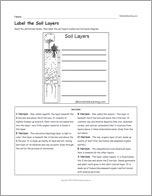Learn about what the inside of Earth is composed of.
Earth’s Layers
The Earth is made of many different and distinct layers. The deeper layers are composed of heavier materials; they are hotter, denser and under much greater pressure than the outer layers.
Core
The Earth has a iron-nickel core that is about 2,100 miles in radius. The inner core may have a temperature up to about 13,000°F (7,200°C = 7,500 K), which is hotter than the surface of the Sun. The inner core (which has a radius of about 750 miles (1,228 km) is solid. The outer core is in a liquid state and is about 1,400 miles (2,260 km) thick.
Mantle
Under the crust is the rocky mantle, which is composed of silicon, oxygen, magnesium, iron, aluminum, and calcium. The upper mantle is rigid and is part of the lithosphere (together with the crust). The lower mantle flows slowly, at a rate of a few centimeters per year. The asthenosphere is a part of the upper mantle that exhibits plastic properties. It is located below the lithosphere (the crust and upper mantle), between about 100 and 250 kilometers deep.
Convection (heat) currents carry heat from the hot inner mantle to the cooler outer mantle. The mantle is about 1,700 miles (2,750 km) thick. The mantle gets warmer with depth; the top of the mantle is about 1,600° F (870° C); towards the bottom of the mantle, the temperature is about 4,000-6,700° F (2,200-3,700° C). The mantle contains most of the mass of the Earth. The Gutenberg discontinuity separates the outer core and the mantle.
Surface and crust
The Earth’s surface is composed mostly of water, basalt and granite. Oceans cover about 70% of Earth’s surface. These oceans are up to 3.7 km deep. The Earth’s thin, rocky crust is composed of silicon, aluminum, calcium, sodium and potassium. For a page on soil, click here.
The crust is divided into continental plates which drift slowly (only a few centimeters each year) atop the less rigid mantle. The crust is thinner under the oceans (6-11 km thick); this is where new crust is formed. Continental crust is about 25-90 km thick. The lithosphere is defined as the crust and the upper mantle, a rigid layer about 100-200 km thick. The Mohorovicic discontinuity is the separation between the crust and the upper mantle.
Read the definitions then label the layers of the Earth in this printable worksheet.
Label the parts of the mantle and crust in this printable worksheet.
Label the growth of new oceanic crust as two plates diverge in this printable worksheet.
Soil covers much of the land on Earth, learn more about it here!
Label the soil layers in this printable worksheet.
Label the subduction of an oceanic plate under a continental plate (plate convergence).
Learn all about volcanoes with this informative page.
Label the lava, vent, conduit, crater, magma chamber, ash cloud and crust.
Label the water cycle in this printable worksheet.


